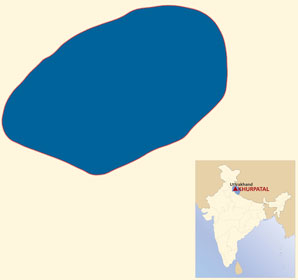| |
|
| |
|
|
|
| |
 |
| |
|
| |
|
| |
Background |
| |
|
| |
Khurpa tal under scanner
Khurpatal is one of the many lakes in Nainital region. It lies in the depression formed by movements in the earth’s crust. Steep slopes surround this water body. Ecological degradation begun in this lake due to excessive inflow of sediments and sewage from surrounding areas and pollution caused by dumping of solid waste in the water body.
Construction of a new housing project adjacent to the Khurpatal by the Army Welfare Housing Organization (AWHO) caused afresh hue and cry among the villagers in the surrounding area when Dr. Ajay S. Rawat, Professor of History in Kumaon University filed a PIL against the illegal boring of groundwater in the area this January. AWHO announced a launch of a building project in the area this year. Khurpa tal being located only 10 km from the Nainital town is also a favorite tourist destination. The constructors had already bought land very near to Khurpatal back in 2000-2001 and started boring wells in the area. The villagers in the area use the lake water for farming.
The villagers residing down hills stood against the exploitation of the groundwater, which they feared would affect their irrigation water. Due to the agitation of the villagers, the District Magistrate stepped into the matter and the construction was stopped. In the year 2006, the builders started the project again with drilling of borewells. The villagers brought this to the notice of the High Court (HC) of Uttarakhand. The court ordered a status quo against the boring activities. The sub divisional officer of the Nainital district ordered the Central Public Works Department (CPWD), to stop the activity.
In response to the request of the villagers, the Commissioner of Kumaon Division approached the Department of Geology and Jal Nigam to submit a survey report on the impact of boring in the lake area. The survey report clearly mentioned how the mindless extraction of groundwater from the area would affect the springs in the downstream area. According to these experts, the lake acts as a source to these springs. The water of the lake passes through fractures to these springs. The farmers depend on these springs and the livelihood of these poor farmers will be affected.
The temporary injunction was rejected in the HC but the villagers again appealed in the District Court and managed to get a stay order.
The final hearing is still pending. In spite of this stay order, AWHO again resumed illegal boring in the area. According to Rawat, there is a fear that the sewage of the building apartments will be directly connected to the water body. The advocate Rajiv Singh Bisht is very hopeful to get justice for the peasants. As a fist phase of achievement, Bisht explains that the court has ordered the Chief Conservator of Forest and District Magistrate of the Nainatal District to visit the site and learn the impact of groundwater mining. Rawat is satisfied of the fact that the civil authorities had stopped the illegal pumping of groundwater, in spite of the fact that the court order is still pending.
|
| |
|
|
| |
 |
|
| |
|
|
| |
|
|
| |
Links |
|
|
| |
|
|
|
| |
|
|
|
| |
 |
|
|
| |
|
|
|
| |
CHRONOLOGY |
|
|
| |
|
|
|
| |
2001: The constructors bought land near to Khurpatal back and started boring wells in the area. It gave rise to agitation by the villagers, because of which the District Magistrate stepped into the matter and the construction was stopped.
2006: The builders started the project again with drilling of borewells. The villagers brought this to the notice of the High Court (HC) and the court ordered a status quo against the boring activities. CPWD was told to stop the activity.
2008: Work started for the construction of housing project by AWHO
2009: Dr. Ajay S. Rawat, Professor of History in Kumaon University filed a PIL against the illegal boring of groundwater in the area, due to construction of housing project by AWHO. |
|
|
| |
|
|
|
| |
 |
|
|
| |
|
|
|
| |
|
|
|
| |
PEOPLE |
|
|
| |
Researchers:
V. K. Dua and R. Kumari and V. P. Ojha
Malaria Research Centre (Field Station),
Section III, BHEL,
Ranipur,
Hardwar 249 403,
India
R. K. Johri
D.A.V. Postgraduate College,
Dehradun 248 001,
India
R. P. Shukla
Malaria Research Centre (Field Station),
Haldwani,
Nainital
V. P. Sharma
Malaria Research Centre,
22 Sham Nath Marg,
Delhi 110 054,
India |
|
|
| |
 |
|
|
| |
|
|
|
|